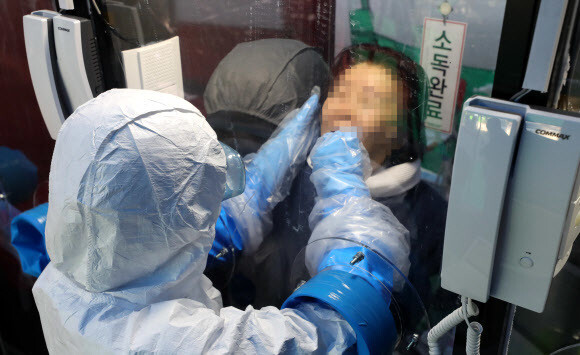hankyoreh
Links to other country sites 다른 나라 사이트 링크
Health authorities under fire for announcing walk-thru airport testing booths without assessing their safety

South Korea’s public health authorities are facing criticism after announcing a plan to set up 40 “walk-thru” COVID-19 testing booths at Incheon International Airport without adequately assessing their safety.
“We’re discussing methods of increasing the safety of the walk-thru screening clinics with infectious disease specialists. We’re reviewing a number of ways to guarantee the speed and safety of testing, such as collecting samples outside the hospital,” said Son Yeong-rae, head of the public relations team for South Korea’s Central Disaster and Safety Countermeasures Headquarters, on Mar. 24.
Safety concerns, including issues related to disinfecting and ventilating the booths, were only raised in an expert review that took place after the plan was announced.
The previous day, the disaster safety headquarters announced that it would be installing 40 walk-thru testing booths at Incheon Airport by Mar. 25 that would be capable of testing individuals in six to seven minutes. The booths are supposed to accelerate testing of people arriving in the country from Europe.
When a patient enters the walk-thru testing booth, which is around the size of a phone booth, a medical worker puts their hands into gloves built into a plastic barrier to collect a sample from the patient. The disaster safety headquarters reportedly drew its inspiration from the walk-thru testing booths in use at H Plus Yangji Hospital, in Seoul’s Gwanak District.
But concerns were raised that the coronavirus could be transmitted by the rubber gloves inserted through the barrier or the vinyl gloves on top and that using a nebulizer to spray disinfectant into the booth could have a harmful effect on the human body. The disaster safety headquarters responded by deciding to supplement the plan, just one day after its announcement, with the goal of opening the booths on Mar. 26 or 27.
Screening clinics that can handle a large volume of tests, including the well-ventilated drive-thru clinics set up outside, have gained attention from around the world. That has prompted the authorities to set up similar facilities, but no guidelines have been developed to guarantee their safety.
“If we only emphasize speed when we set up large-scale testing centers, there’s a possibility of uninfected people being infected during testing or receiving a false positive. We need to think carefully about whether we might be harming people by being in such a hurry to disinfect the testing space,” said Kim Jin-yong, head of the division of infectious disease at Incheon Medical Center and the first person to suggest drive-thru testing.
“The rubber gloves inserted through the barrier are replaced on a regular basis. Each time a sample is collected, medical staff in Level D protective gear enter the booth to replace the vinyl gloves on top,” explained a spokesperson for H Plus Yangji Hospital.
By Park Hyun-jung, staff reporter
Please direct comments or questions to [english@hani.co.kr]

Editorial・opinion
![[Editorial] Penalties for airing allegations against Korea’s first lady endanger free press [Editorial] Penalties for airing allegations against Korea’s first lady endanger free press](https://flexible.img.hani.co.kr/flexible/normal/500/300/imgdb/original/2024/0502/1817146398095106.jpg) [Editorial] Penalties for airing allegations against Korea’s first lady endanger free press
[Editorial] Penalties for airing allegations against Korea’s first lady endanger free press![[Editorial] Yoon must halt procurement of SM-3 interceptor missiles [Editorial] Yoon must halt procurement of SM-3 interceptor missiles](https://flexible.img.hani.co.kr/flexible/normal/500/300/imgdb/child/2024/0501/17145495551605_1717145495195344.jpg) [Editorial] Yoon must halt procurement of SM-3 interceptor missiles
[Editorial] Yoon must halt procurement of SM-3 interceptor missiles- [Guest essay] Maybe Korea’s rapid population decline is an opportunity, not a crisis
- [Column] Can Yoon steer diplomacy with Russia, China back on track?
- [Column] Season 2 of special prosecutor probe may be coming to Korea soon
- [Column] Park Geun-hye déjà vu in Yoon Suk-yeol
- [Editorial] New weight of N. Korea’s nuclear threats makes dialogue all the more urgent
- [Guest essay] The real reason Korea’s new right wants to dub Rhee a founding father
- [Column] ‘Choson’: Is it time we start referring to N. Korea in its own terms?
- [Editorial] Japan’s rewriting of history with Korea has gone too far
Most viewed articles
- 1Months and months of overdue wages are pushing migrant workers in Korea into debt
- 2[Editorial] Penalties for airing allegations against Korea’s first lady endanger free press
- 3Bills for Itaewon crush inquiry, special counsel probe into Marine’s death pass National Assembly
- 4Trump asks why US would defend Korea, hints at hiking Seoul’s defense cost burden
- 560% of young Koreans see no need to have kids after marriage
- 6S. Korea discusses participation in defense development with AUKUS alliance
- 7[Reporter’s notebook] In Min’s world, she’s the artist — and NewJeans is her art
- 8Korean firms cut costs, work overtime amid global economic uncertainties
- 91 in 3 S. Korean security experts support nuclear armament, CSIS finds
- 10[Guest essay] Maybe Korea’s rapid population decline is an opportunity, not a crisis